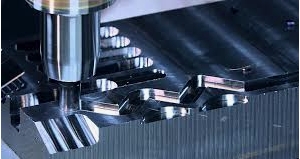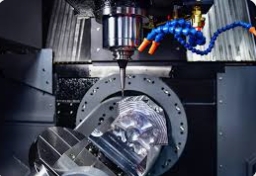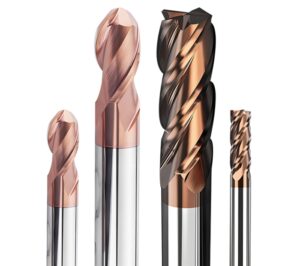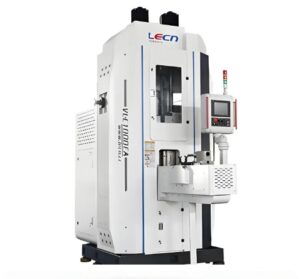August 29, 2024
CNC Engraving Processing Frequently Asked Questions
Many industries widely use CNC engraving machines, including 3C, mold and die, and medical fields. These machines are popular because they can use small-diameter tools for finishing.This article will analyze the common problems in CNC engraving processing.
1. What is the main difference between CNC engraving and CNC milling?
CNC engraving and CNC milling are both based on the milling principle, but the main difference lies in the diameter of the tool; CNC milling usually uses a tool with a diameter of 6-40 mm, while CNC engraving uses a tool with a diameter of 0.2-3 mm. The use of small-diameter tools makes CNC engraving machines excel in fine machining.

2. Can CNC milling be used only for roughing, while CNC engraving is used only for finishing?
Roughing, semi-finishing, and finishing represent different stages of processing. Each stage corresponds to a different processing volume. CNC milling can handle both roughing and finishing. In comparison, CNC engraving is mainly used for finishing. It is suitable for light-cutting operations. Can the NC engraving process perform rough machining on steel?
The capability of CNC engraving depends mainly on the tool diameter. Engraving tools usually have small diameters. This limits their cutting capacity. For mold shapes that require tools with diameters greater than 6 mm, complete the roughing process using CNC milling. Afterward, use the engraving process to remove the remaining material.
4. Can engraving be accomplished by adding an incremental head to a CNC machining center?
No, it will not. Although the incremental head can increase the spindle speed, the overall design of the CNC machining center does not take into account the fine machining requirements of small tools. High-speed spindles are not the only feature of an engraving machine, so adding an incremental head to a machining center will not meet the needs of engraving.

5. CNC engraving can use small diameter tools, it can replace the EDM?
No, it cannot replace it. Although CNC engraving has advantages in small mold machining, its tool length/diameter ratio is usually 5:1, limiting the ability to machine deep cavities. EDM can accomplish deep cavities without cutting forces, which is not possible with engraving.
6. What are the main factors affecting engraving?
Factors affecting engraving include machine characteristics, tool quality, control system, material properties, machining process, auxiliary fixtures, and machining environment. Each factor has a significant impact on machining accuracy and efficiency.
7. CNC engraving processing on the control system requirements?
CNC engraving requires a control system with milling control capability. In addition, the control system must provide feed-forward capability, slowing down in advance to minimize the frequency of small tool breakage, while increasing feed rates on smooth paths to improve machining efficiency.
8. What material properties affect engraving?
The type, hardne,s s, and toughness of the material will affect the engraving process. Materials with higher hardness and viscosity are less machinable. Materials with a higher content of non-metallic elements are more machinable. However, manufacturers usually tightly control the non-metallic content of the material.
9. Which materials are suitable for engraving?
Non-metallic materials suitable for engraving include plexiglass, re,s in, and wood, while those unsuitable for engraving include natural marble and glass. Metal materials suitable for engraving include copper, alum, Inu, m, and soft steel with hardness below HRC40, while metal materials unsuitable for engraving include hardened steel.
10. What t The impact of the tool on the engraving process and how to info influence it?
The factors affecting the tool include tool material, geometric parameters, and grinding technology. Carbide tools have high wear resistance due to their powder alloy material, and the sharpness of the tool directly affects the cutting force and surface quality. The higher the grit of the grinding wheel used to sharpen the tool, the finer the cutting edge, and the higher the durability and surface quality of the tool.
11. What is the tool life formula?
The formula for tool life (T) is \[T=\frac{CT}{VC\cdotf\cdotP}\] where CT is the life parameter, VC is the cutting line speed, f is the feed per revolution and P is the depth of cut. Cutting line speed has the greatest impact on tool life, while tool radial runout, grinding quality, materials, and coatings also affect tool durability.
12. How to protect the engraving machine equipment?
- Protect the tool setting gauge from soil erosion.
- Control flying chips to prevent them from damaging the machine tool.
- Pay attention to the use of lighting to avoid pulling the lamp head.
- Avoid approaching the cutting area during processing.
- Avoid opening and closing the machine door violently.
- Start the spindle before machining to avoid overloading the motor.
- Prohibit placing tools or workpieces on the machine beam.
- Avoid placing magnetic tools on the electric control cabinet to prevent damage to the display.
13. What parameters need to be adjusted when there is a hold-up phenomenon?
When a hold-up occurs, the spindle power and torque are usually insufficient. The team should re-optimize the path to reduce the depth of cut, grooving depth, h, and trimming amount. At the same time, they can adjust the feed rate to improve the cutting condition.
14. What is the role of cutting fluid?
The main uses of cutting fluid are cooling and lubrication. Its role includes taking away cutting heat and flying chips, reducing the temperature of tools and motors, and improving their service life. Cutting fluid also reduces cutting forces, improves machining stability, and improves surface quality by choosing oily cutting fluid when machining copper.
15. What are the stages of tool wear?
Tool wear has three stages: initial wear, normal wear, and sharp wear. In the initial wear stage, the tool temperature is not optimal. This mainly causes abrasive wear. In the normal wear stage, the tool temperature reaches the standard. This stage is mainly characterized by diffusion. In the sharp wear stage, the tool fails.
16. The need and method of tool grinding?
Tool grinding can effectively extend tool life and avoid the chipping phenomenon. The grinding method is: to maintain a reasonable spindle speed and reduce the feed rate by half, the machining time is about 5 to 10 minutes. Choose a shorter time for soft materials and a longer time for hard metals.
17. How to judge serious tool wear?
Criteria for judging severe tool wear include:
- Abnormally harsh machining sound.
- The spindle is holding back the rotation phenomenon.
- Increased vibration of machine and machine spindle vibration is obvious.
- Poor machining results and uneven tool patterns.
18. When to change tools?
Change the tool at 2/3 of its tool life. For example, if the tool shows severe wear within 60 minutes, change the tool at 40 minutes. Develop the habit of changing tools regularly.
Use cutting fluid mainly for cooling and lubrication.
19. Can we continue to machine severely worn tools?
Severely worn tools significantly increase the cutting forces, resulting in a significant reduction in spindle motor life. For example, a 3-fold increase in cutting force will shorten the actual spindle motor life to 1/3 of normal use.
20. How do I determine the tool extension length for roughing?
The tool extension length should be as short as possible to improve machining stability. Normally, a tool shank with a diameter of φ3 mm extends 5 mm, a tool shank with a diameter of φ4 mm extends 7 mm, and a tool shank with a diameter of φ6 mm extends 10 mm. It should be controlled within these ranges as much as possible to optimize machining efficiency.

21. How to deal with broken tools during machining?
- Stop machining and check the serial number of the broken tool.
- Remove the broken part of the tool.
- Analyze the cause of the broken tool, including a sudden increase in tool force, path problem, tool jitter, hard material, or inaccurate spindle speed.
- Replace the tool and make necessary path adjustments and feed rate reductions.
22. Parameter adjustment method whether the roughing condition is poor.
If the tool life cannot be guaranteed even at a reasonable spindle speed, adjust the depth of cut first. Then, adjust the feed rate. Finally, adjust the lateral feed. Usually, the depth of cut should not be less than 0.1 mm to avoid machining efficiency being too low.
